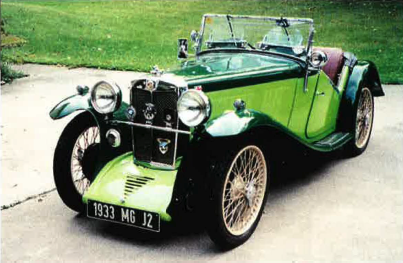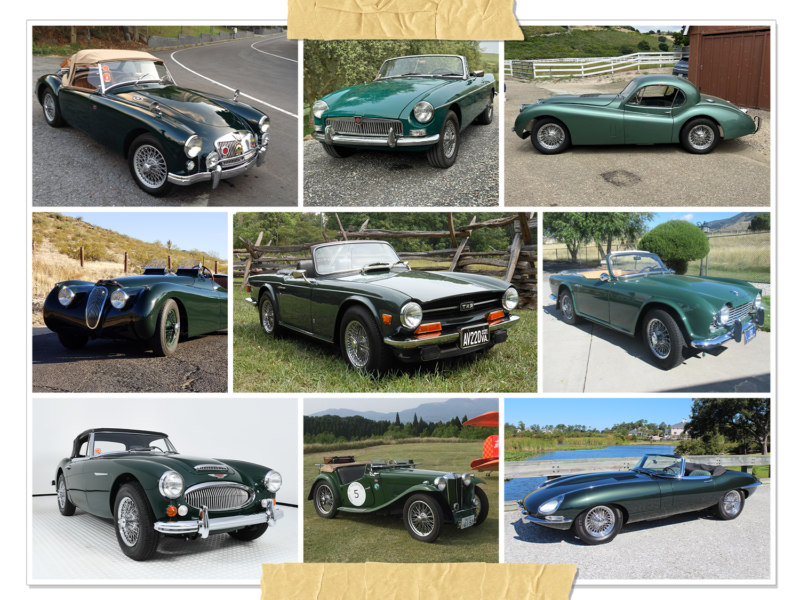To read the first part of this series, click the following link:
In which Sam Bennett continues his story of life in the MG factory during the emergence of the MG sports car.
By Marcham Rhoade
I carried on working in the rectification department for some time on the J2s being produced at Abingdon in 1932. Some of my fellow workers were notable names, such as Alec Hounslow, Cyril Brown, and Cliff Welsh. Two of the apprentices were Ron Amey (later to find fame as the head of the Amey Roadstone Corporation, Britain’s premier builder of highways) and the son of a high-ranking officer at the nearby R.A.F station at Abingdon. One day, George Morris brought in a young man to get an insight into the workings of the MG Car Co. He was Dutch, from Utrecht, Delft, by the name of Jan Aryjanson. His father had a car dealership, and when Jan returned to Holland, he kindly wrote and informed me that he had opened a place of his own, selling MGs, and ran it just the way he was taught at Abingdon. He added that he never dreamed it would do so well!
In the factory, the main problems we had to rectify on the J2s were the top and bottom bevel gears for the overhead camshaft drive. We oftentimes had to re-shim these extensively, as the gear train would get very noisy in short order. This was due to the fact that the mating bevel gears were originally made in pairs, and were lapped together with grinding compound during the final stages of manufacture. This would ensure quiet running, but only if they were installed in the exact same relative position. The engine branch boys often failed to take this into consideration.
With great care, we would re-shim, for fore, aft, up, and down positioning in order to get the upper and lower gears to mesh correctly while still ensuring proper timing. This was quite a job, as it entailed completely removing the dynamo, and complete vertical drive assembly. It’s little wonder that MG did away with the overhead cams a few years later!
The rear axle suffered a similar problem. If it was noisy in drive, then it was deep in mesh, and shims were again needed, as they were also if the axle was noisy on over-run. More shims would be required to eliminate the noise drawing the pinion back, and maybe we would have to do this three or four times, draining the oil off each time to try and make the axle less noisy.
Another fault was the oil pump, which used to make a noise I can only describe as a crackle. Here we had to take the back plate off the pump where the wheels were exposed, one made of steel, the driver and the other being phosphor bronze. They went on a dowel, as a sort of dummy with a loose drive. Where the plate had been marked by the wheels, just where the teeth marks had been, we used to take a three-cornered file and relieve it just a little where the teeth met, which usually cured the crackle. However, one day, one of my fellow workers lifted the oil pump up, took the back plate off, drained the little bit of loose oil which was always present in the pump, and went over to his bench to use the vice. Now the loose wheel which was supposed to stick on the dowel didn’t, and the wheel dropped into his oil pan. He failed to realize the wheel was missing, so he put the back plate on again without the wheel, and the car went out on test and seized up.
As you worked on the rejects, if you were short of anything to complete a particular task, you would put it over to one side in an empty bay, and pick up another job off the line. On one occasion, I had put a chassis to one side and carried on working on another until such time as I got the proper part to finish the job. When I returned to the first chassis, I attached my petrol tin tank to the back of the chassis and, as I have already described, the wiring was exposed in a bunch. You soon learned which two colored wires you had to twist together to get the petrol pump going. This particular time, unbeknown, and unlucky for me, someone had “borrowed” the petrol pipes off the carburetors from the car which had been left by me. When I twisted the two wires together to start the pump, the petrol spurted out all over my hands. When I pulled the wires apart quickly, the resulting spark caused the petrol on my hands to ignite.
I immediately brushed the blazing petrol off my hands onto the ground, and stuck my hands under my arms to douse the flames. The other lads came rushing to my aid, and fortunately I was okay, although to this day the backs of my hands have a glossy shine where they were burned all those years ago.
Talking of fire reminds me of another occasion when we had two cars in the bays and another on trestles. Somehow they caught fire, shooting flames up to the roof of the rectification shop, taking all the glass out of the roof. The burning roof then fell on to the other trestles and all three cars were severely damaged. Many will have heard of the famous MG works fire brigade—well, they were very efficient and did a superb job! However, they couldn’t help the chap whose wrist was severely burned after the metal strap of his wristwatch shorted across a battery! After that, these straps, which were the latest fashion in those days, were forbidden in the MG works.
At this time, all MGs were road-tested, and when the testers went out the door of the workshops, they would make a racing change almost before they’d reached the door! This used to make tire marks on the floor, due to wheelspin, and sometimes you could count the number of changes by the marks on the floor. I never tried this myself in case I chewed up the gearbox, but the testers were all expert drivers, even if a little adventurous sometimes.
One day, a number of the Lancashire police came to the works to pick up a new batch of J2s, which they were proposing to employ on traffic duties. All the policemen wanted to have a ride out with the testers, which they did. However, upon returning to the works, one of the testers came hurtling through the doorway, whereupon he stamped on the brakes, literally standing the little MG up on its end. He stopped about a foot behind the line of Js waiting to go out, at which point it was the policeman’s hair which virtually stood on end! It probably never occurred to the policeman that at this time, these chaps were doing this type of driving every day, all day, and knew the idiosyncrasies and limits of the J2s intimately.
On the works notice board there was a map of the area around the factory, and on this map were marked the various points where complaints had been made to the police about the test drivers taking bends on narrow roads at great speeds. This was brought to the attention of the testers, but it seemed to make very little difference. Many a time when a car came back from a test run, we had to remove the odd bird from between wing and bonnet, and there were always butterflies, dragonflies, and just plain flies, that were brought back stuck to the cars in their millions, usually in the radiator grille.
Other police cars were the L-Type Magnas, in addition to the Midgets, as they were known then. I recall the Derbyshire police force collected six Midgets, and within a very short time, they were all back with us at Abingdon, all with sheared prop shafts. We soon discovered what the problem was—the mechanic at the police station had fitted a fire extinguisher to each of the cars on the transmission tunnel. However, the bolts he had used to attach the extinguishers were about an inch and a half long, and the float of the rear axle meant that the propshaft would come up and catch the bolts, which sheared the shaft. We had to rectify each one and use shorter bolts to reaffix the extinguishers.
Occasionally a car failed on test, and I remember having to go out to Devizes, in Wiltshire, with a Morris Commercial van to bring back a stricken J2 by means of towing it. The MG had suffered a broken crankshaft, and I will never forget that short ride back to Abingdon! The towrope we had taken was extremely short, and the van driver, having hooked up to one of the front dumb irons of the MG, set off at great speed northwards, with myself in the J2 snaking all over the road! When we got back to the works, the car needed new brake linings due to me standing on the brakes to keep the towrope as tight as possible! However, it all added to the fun and interest, not to mention the excitement of working at MG in the ’30s.








'Abingdon in the 1930s, Part II' has no comments
Be the first to comment this post!